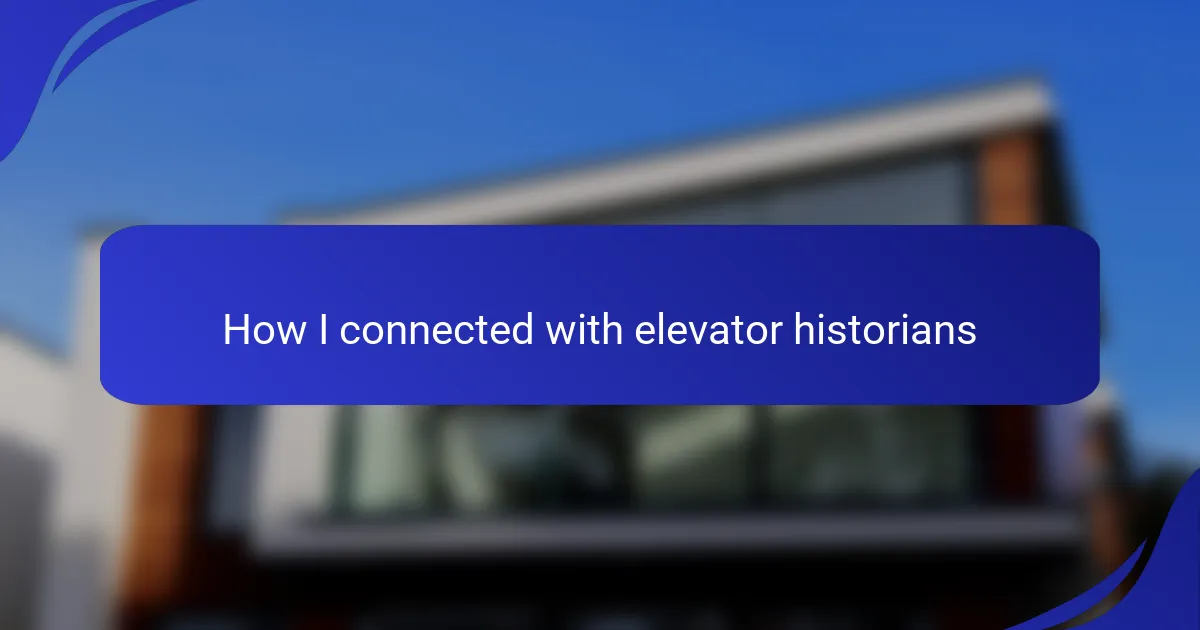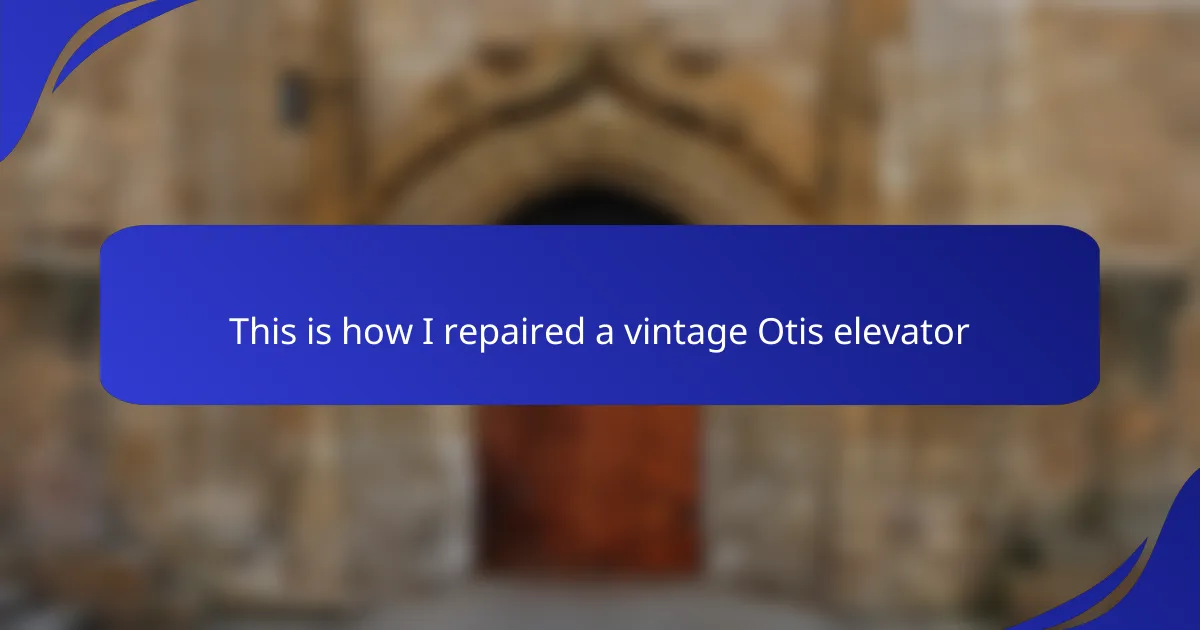Key takeaways
- The elevator industry has evolved from ancient hoisting devices to modern smart elevators, significantly influencing urban design and skyscraper construction.
- Elisha Graves Otis’s invention of the safety elevator in 1852 revolutionized public perception and safety of vertical transportation.
- Elevators have enabled denser urban living by facilitating vertical expansion and mixed-use developments, transforming city landscapes.
- Engaging with elevator historians and enthusiasts provides valuable insights into the industry’s history and its broader social implications.
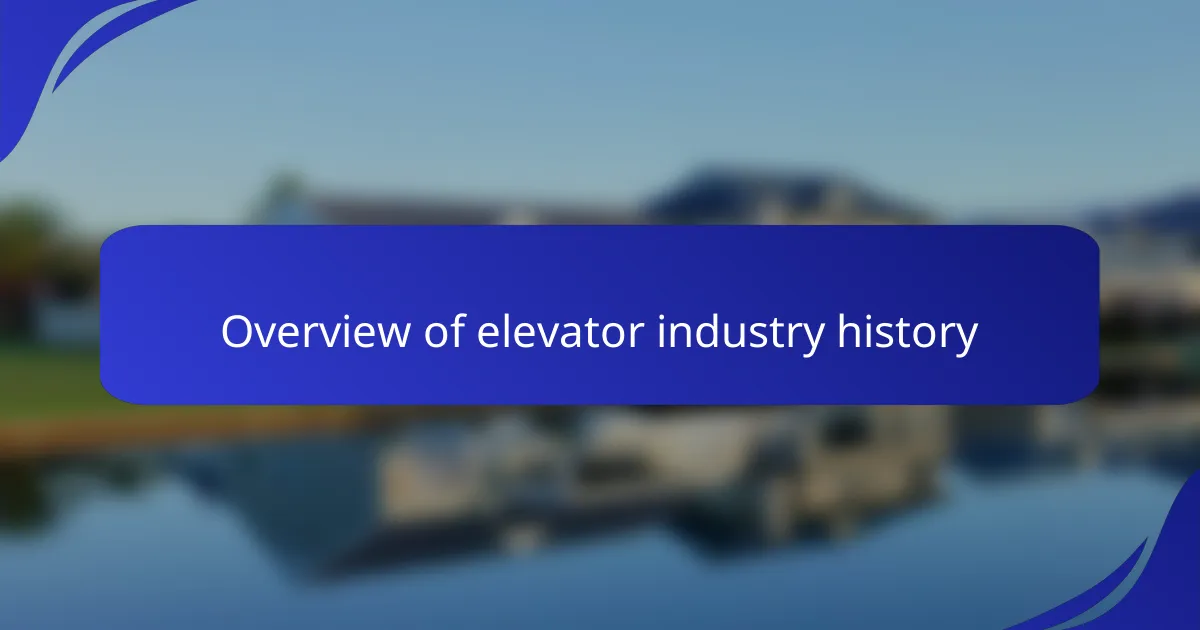
Overview of Elevator Industry History
The elevator industry has a fascinating history that perfectly blends innovation and necessity. I remember the first time I learned about the origins of elevators – it was like uncovering a hidden treasure of knowledge. The transformation from simple hoisting devices to the complex, smart elevators we have today showcases human ingenuity at its finest.
Here’s a brief overview of key milestones in elevator industry history:
- Ancient Times: Early forms of elevators appear around 300 BC, driven by animals or manpower.
- 19th Century: The introduction of the steam engine paved the way for mechanized elevators, enhancing efficiency.
- 1852: Elisha Graves Otis invents the safety elevator, introducing a braking system that prevents falls, fundamentally changing the industry.
- 20th Century: The rise of skyscrapers leads to advancements in elevator technology, including the development of electric elevators.
- 21st Century: Smart technology integrates with elevators, improving efficiency and user experience while prioritizing safety.
Reflecting on these milestones, it’s remarkable how each advancement not only shaped the industry but also changed our urban landscape and daily lives.
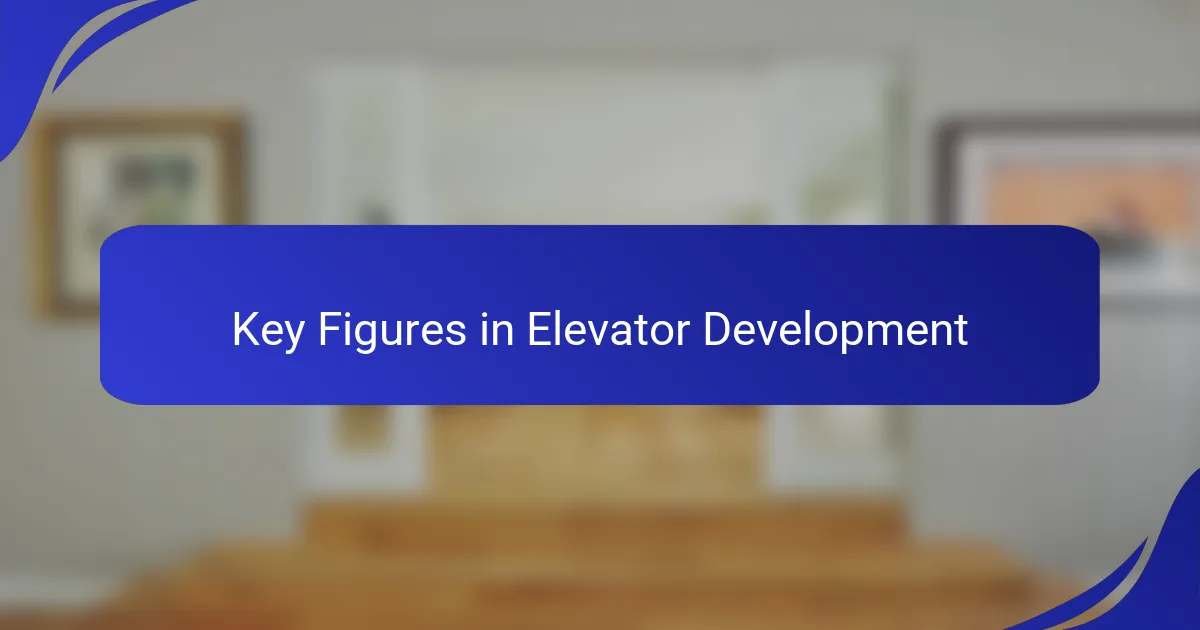
Key Figures in Elevator Development
When I think about key figures in elevator development, Elisha Graves Otis immediately comes to mind. His invention of the safety elevator in 1852 was a game-changer, introducing a braking system that transformed public perception of elevators. I often wonder how different our cities would look today if he hadn’t paved the way for safer vertical transportation.
Another pivotal figure is Otis’s own company, which played a crucial role in popularizing elevators in skyscrapers. It’s fascinating to see how the partnership between engineering and architecture blossomed during the 19th and 20th centuries. I can only imagine the excitement in the air as cities began to reach new heights, literally and figuratively, thanks to these innovative minds.
In more recent history, the advancements in electric elevators pushed the boundaries of what was possible, allowing buildings to soar even higher. I find it intriguing how these developments mirrored a growing urbanization trend. It makes me appreciate the forward-thinking visionaries who continually sought to enhance mobility and efficiency in our growing metropolises.

Impact of Elevators on Urban Design
It’s fascinating to consider how elevators have transformed urban landscapes. When I walk through bustling cities, I often find myself in awe of the skyline, where skyscrapers stand tall, thanks in part to elevators. These incredible machines have not only made vertical transportation possible but have also influenced the very design of buildings and the layout of cities.
I vividly remember standing at the foot of a soaring tower, feeling a mix of excitement and a hint of vertigo. That feeling reminded me just how vital elevators are to our everyday experiences in urban environments. Without them, we would likely see a very different architectural approach—one that’s more focused on horizontal expansion rather than reaching for the skies.
Elevators have allowed for more efficient use of space, making urban areas denser and more livable. They create opportunities for mixed-use developments, where residential and commercial spaces coexist, fostering a vibrant community feel that can be hard to find in less densely populated areas.
| Feature | Impact of Elevators on Urban Design |
|---|---|
| Vertical Expansion | Allowed cities to grow taller and accommodate more people in less land area. |
| Architectural Innovation | Inspired designs that prioritize height and design complexity. |
| Community Integration | Facilitated mixed-use spaces, enhancing urban living. |

Researching Elevator History Resources
Diving into elevator history resources was a journey filled with fascinating discoveries. I remember the excitement I felt when I stumbled upon an old elevator patent from the late 1800s. It was like uncovering a hidden treasure that revealed not just the mechanics, but also the innovative spirit of that era. Each resource seemed to unveil another layer of the narrative surrounding elevators, making me appreciate their evolution even more.
As I navigated various archives and online databases, a few key resources stood out that can guide anyone interested in elevator history:
-
Historical Societies and Museums: Local historical societies often house a wealth of information, from blueprints to photographs. Visiting these places can lead to unexpected finds.
-
Academic Journals: Reading published studies on elevator technology trends and historical usage provides deep insights into the industry’s evolution.
-
Online Forums: Engaging with communities of enthusiasts and historians can yield personal anecdotes and unique perspectives on elevator history.
-
Library Archives: Many libraries have dedicated sections for industrial history, which can be invaluable for research.
-
Documentaries and Video Archives: Watching documentaries can visually illustrate the significance and progression of elevator technology over the years.
Being part of this exploration not only deepened my understanding but also fostered connections with fellow enthusiasts who share a passion for this often overlooked aspect of engineering history.

My Journey into Elevator History
My fascination with elevator history began unexpectedly during a visit to a historic building. I was captivated by the intricate mechanics and design of the original elevator system. It felt like stepping back in time, and I wondered about the stories behind each component. This sparked my curiosity and pushed me to delve deeper into the origins and evolution of elevators.
As I connected with elevator historians, I discovered a vibrant community whose passion mirrored my own. Their enthusiasm for sharing knowledge was infectious and often led to animated discussions. I learned how elevators have shaped urban landscapes and transformed daily life, making the exploration all the more enriching.
- Attended local history talks focused on elevator innovations.
- Joined online forums where stories of elevator pioneers are shared.
- Developed personal connections with historians through shared research.
- Explored archives and collections that revealed the evolution of elevator technology.
- Participated in tours of historic elevator installations, enhancing my understanding of their significance.
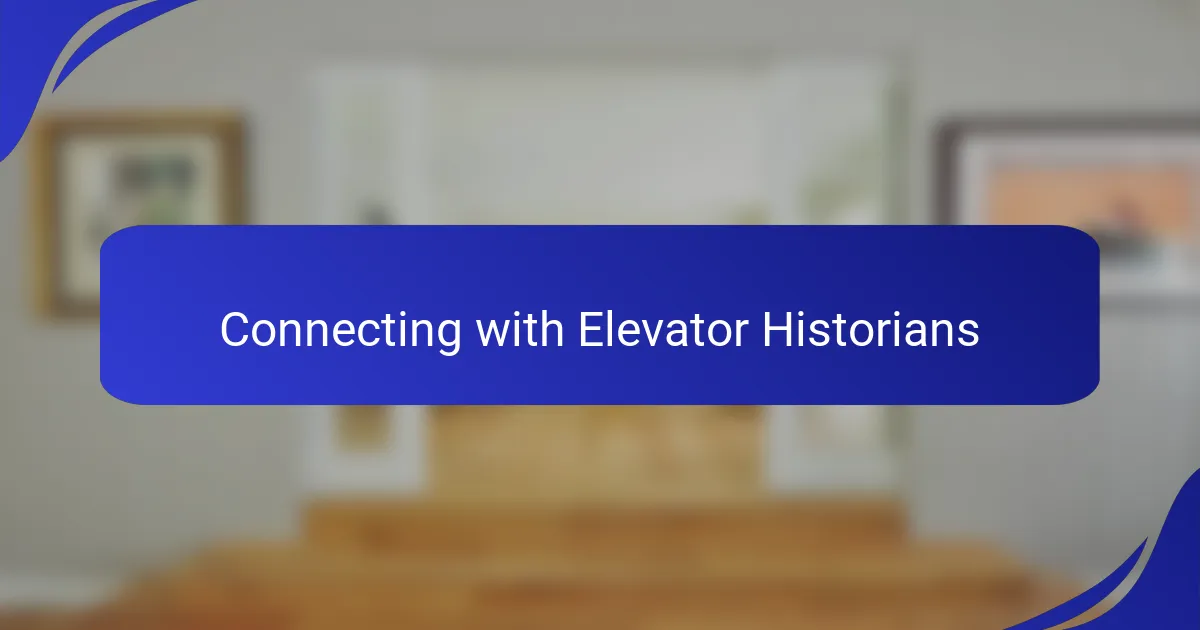
Connecting with Elevator Historians
Connecting with elevator historians has been an enlightening experience for me. At one of the local history talks, I found myself enthralled by stories of the early pioneers who made vertical transport a reality. Listening to these experts share their knowledge felt like stepping into a time machine, allowing me to grasp not just the innovations, but the emotions and challenges that shaped the industry. Have you ever felt that thrill of connecting with someone who shares your passion?
In my journey, I’ve found online forums to be a goldmine of insights. Here, enthusiasts and historians alike exchange personal experiences, anecdotes, and rare photographs that highlight pivotal moments in elevator history. One day, I stumbled upon a thread discussing a vintage elevator model, and the nostalgic tales it sparked among participants reminded me of my childhood fascination with architecture. There’s something magical about finding others who appreciate these details.
As I explored various archives, I was often struck by how each document revealed a different layer of elevator evolution. It was like piecing together a puzzle where every piece told its own story. Connecting with historians provided not just knowledge but also a sense of belonging to a community united by a shared appreciation for an often-overlooked aspect of engineering. Each connection has deepened my passion and understanding, making this journey even more fulfilling.

Insights from Elevator History Experts
The insights I’ve gained from elevator history experts have truly enriched my understanding of this remarkable industry. For instance, while discussing the evolution of safety mechanisms with a historian, I was fascinated to learn how pivotal moments in engineering shaped public trust in elevators. This realization struck a chord with me—can you imagine the uncertainty people felt before Elisha Graves Otis made elevators safe for widespread use?
During one of our conversations, a historian shared fascinating anecdotes about the 19th-century skyscrapers and how elevators enabled these architectural marvels. I can still picture the excitement in their eyes as they described the first time elevators made it feasible for people to live and work higher off the ground. It made me reflect on how integral elevators are to our modern urban life. Without them, would cities have transformed the way they did?
Engaging with these experts has highlighted the broader implications of elevator technology beyond simply moving people up and down. For example, one historian emphasized how elevators helped redefine social hierarchies by making upper floors more accessible. This insight pushed me to reconsider my experience visiting tall buildings and the different atmospheres present at various heights. Such perspectives make me grateful for the opportunity to connect with those who hold a treasure trove of experiences and insights about our vertical world.
